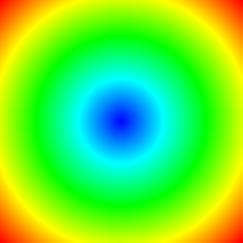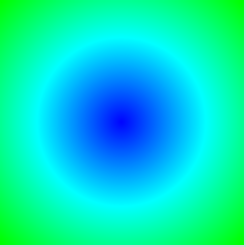溫馨提示×
您好,登錄后才能下訂單哦!
點擊 登錄注冊 即表示同意《億速云用戶服務條款》
您好,登錄后才能下訂單哦!
這篇文章主要介紹“C++基于灰度圖上色GrayToColorFromOther怎么實現”的相關知識,小編通過實際案例向大家展示操作過程,操作方法簡單快捷,實用性強,希望這篇“C++基于灰度圖上色GrayToColorFromOther怎么實現”文章能幫助大家解決問題。
之前有提到給灰度圖上色的需求,在此基礎上,還有一種需求,就是基于另一張參考灰度圖的色板來給當前的灰度圖上色,比如參考灰度圖的數值區間為-10到10,顏色從藍到綠再到紅,而當前的灰度圖的數據區間為-1到1,若基于參考灰度圖的色板確定數據對應的顏色,則當前灰度圖的顏色應該在綠色左右波動。
下方為具體實現函數和測試代碼。
/**
* @brief GrayToColorFromOther 灰度圖上色,基于參考灰度圖的色板
* @param phase1 輸入的灰色圖像,通道為1,提供色板
* @param phase2 輸入的灰色圖像,通道為1,基于phase1的色板繪色
* @return 上色后的圖像
*/
cv::Mat GrayToColorFromOther(cv::Mat &phase1, cv::Mat &phase2)
{
CV_Assert(phase1.channels() == 1);
CV_Assert(phase2.channels() == 1);
if (phase1.empty() || phase2.empty())
{
cv::Mat result = cv::Mat::zeros(100, 100, CV_8UC3);
return result;
}
cv::Mat temp, result, mask;
double max1, min1;
int row = phase2.rows;
int col = phase2.cols;
// 確定參考灰度圖的數據范圍
cv::minMaxIdx(phase1, &min1, &max1, nullptr, nullptr, phase1 == phase1);
// 將當前灰度圖以參考灰度圖的數據范圍作標準,進行數據變換
temp = phase2.clone();
for (int i = 0; i < row; ++i)
{
float *t2 = temp.ptr<float>(i);
for (int j = 0; j < col; ++j)
{
t2[j] = 255.0f*(phase2.at<float>(i, j) - min1) / (max1 - min1);
}
}
temp.convertTo(temp, CV_8UC1);
// 創建掩膜,目的是為了隔離nan值的干擾
mask = cv::Mat::zeros(phase2.size(), CV_8UC1);
mask.setTo(255, phase2 == phase2);
// 初始化三通道顏色圖
cv::Mat color1, color2, color3;
color1 = cv::Mat::zeros(temp.size(), temp.type());
color2 = cv::Mat::zeros(temp.size(), temp.type());
color3 = cv::Mat::zeros(temp.size(), temp.type());
// 基于灰度圖的灰度層級,給其上色,最底的灰度值0為藍色(255,0,0),最高的灰度值255為紅色(0,0,255),中間的灰度值127為綠色(0,255,0)
for (int i = 0; i < row; ++i)
{
uchar *c1 = color1.ptr<uchar>(i);
uchar *c2 = color2.ptr<uchar>(i);
uchar *c3 = color3.ptr<uchar>(i);
uchar *r = temp.ptr<uchar>(i);
uchar *m = mask.ptr<uchar>(i);
for (int j = 0; j < col; ++j)
{
if (m[j] == 255)
{
if (r[j] > (3 * 255 / 4) && r[j] <= 255)
{
c1[j] = 255;
c2[j] = 4 * (255 - r[j]);
c3[j] = 0;
}
else if (r[j] <= (3 * 255 / 4) && r[j] > (255 / 2))
{
c1[j] = 255 - 4 * (3 * 255 / 4 - r[j]);
c2[j] = 255;
c3[j] = 0;
}
else if (r[j] <= (255 / 2) && r[j] > (255 / 4))
{
c1[j] = 0;
c2[j] = 255;
c3[j] = 4 * (255 / 2 - r[j]);
}
else if (r[j] <= (255 / 4) && r[j] >= 0)
{
c1[j] = 0;
c2[j] = 255 - 4 * (255 / 4 - r[j]);
c3[j] = 255;
}
else {
c1[j] = 0;
c2[j] = 0;
c3[j] = 0;
}
}
}
}
// 三通道合并,得到顏色圖
vector<cv::Mat> images;
images.push_back(color3);
images.push_back(color2);
images.push_back(color1);
cv::merge(images, result);
return result;
}#include<iostream>
#include<opencv2/opencv.hpp>
#include<ctime>
using namespace std;
using namespace cv;
void UnitPolar(int squaresize, cv::Mat& mag,cv::Mat& ang);
void UnitCart(int squaresize, cv::Mat& x, cv::Mat& y);
cv::Mat GrayToColor(cv::Mat &phase);
cv::Mat GrayToColorFromOther(cv::Mat &phase1, cv::Mat &phase2);
int main(void)
{
cv::Mat mag, ang,result,result2;
UnitPolar(2001, mag, ang);
mag.at<float>(10, 10) = nan("");
cv::Mat mag2 = mag / 2;
result = GrayToColor(mag);
result2= GrayToColorFromOther(mag,mag2);
system("pause");
return 0;
}
void UnitPolar(int squaresize, cv::Mat& mag,cv::Mat& ang) {
cv::Mat x;
cv::Mat y;
UnitCart(squaresize, x, y); //產生指定范圍內的指定數量點數,相鄰數據跨度相同
// OpenCV自帶的轉換有精度限制,導致結果有一定差異性
//cv::cartToPolar(x, y, mag, ang, false); //坐標轉換
mag = cv::Mat(x.size(), x.type());
ang = cv::Mat(x.size(), x.type());
int row = mag.rows;
int col = mag.cols;
float *m, *a, *xx, *yy;
for (int i = 0; i < row; ++i)
{
m = mag.ptr<float>(i);
a = ang.ptr<float>(i);
xx = x.ptr<float>(i);
yy = y.ptr<float>(i);
for (int j = 0; j < col; ++j)
{
m[j] = sqrt(xx[j] * xx[j] + yy[j] * yy[j]);
a[j] = atan2(yy[j], xx[j]);
}
}
}
void UnitCart(int squaresize, cv::Mat& x, cv::Mat& y) {
CV_Assert(squaresize % 2 == 1);
x.create(squaresize, squaresize, CV_32FC1);
y.create(squaresize, squaresize, CV_32FC1);
//設置邊界
x.col(0).setTo(-1.0);
x.col(squaresize - 1).setTo(1.0f);
y.row(0).setTo(1.0);
y.row(squaresize - 1).setTo(-1.0f);
float delta = 2.0f / (squaresize - 1.0f); //兩個元素的間隔
//計算其他位置的值
for (int i = 1; i < squaresize - 1; ++i) {
x.col(i) = -1.0f + i * delta;
y.row(i) = 1.0f - i * delta;
}
}
/**
* @brief GrayToColor 灰度圖上色
* @param phase 輸入的灰色圖像,通道為1
* @return 上色后的圖像
*/
cv::Mat GrayToColor(cv::Mat &phase)
{
CV_Assert(phase.channels() == 1);
cv::Mat temp, result, mask;
// 將灰度圖重新歸一化至0-255
cv::normalize(phase, temp, 255, 0, cv::NORM_MINMAX);
temp.convertTo(temp, CV_8UC1);
// 創建掩膜,目的是為了隔離nan值的干擾
mask = cv::Mat::zeros(phase.size(), CV_8UC1);
mask.setTo(255, phase == phase);
// 初始化三通道顏色圖
cv::Mat color1, color2, color3;
color1 = cv::Mat::zeros(temp.size(), temp.type());
color2 = cv::Mat::zeros(temp.size(), temp.type());
color3 = cv::Mat::zeros(temp.size(), temp.type());
int row = phase.rows;
int col = phase.cols;
// 基于灰度圖的灰度層級,給其上色,最底的灰度值0為藍色(255,0,0),最高的灰度值255為紅色(0,0,255),中間的灰度值127為綠色(0,255,0)
// 不要驚訝藍色為什么是(255,0,0),因為OpenCV中是BGR而不是RGB
for (int i = 0; i < row; ++i)
{
uchar *c1 = color1.ptr<uchar>(i);
uchar *c2 = color2.ptr<uchar>(i);
uchar *c3 = color3.ptr<uchar>(i);
uchar *r = temp.ptr<uchar>(i);
uchar *m = mask.ptr<uchar>(i);
for (int j = 0; j < col; ++j)
{
if (m[j] == 255)
{
if (r[j] > (3 * 255 / 4) && r[j] <= 255)
{
c1[j] = 255;
c2[j] = 4 * (255 - r[j]);
c3[j] = 0;
}
else if (r[j] <= (3 * 255 / 4) && r[j] > (255 / 2))
{
c1[j] = 255 - 4 * (3 * 255 / 4 - r[j]);
c2[j] = 255;
c3[j] = 0;
}
else if (r[j] <= (255 / 2) && r[j] > (255 / 4))
{
c1[j] = 0;
c2[j] = 255;
c3[j] = 4 * (255 / 2 - r[j]);
}
else if (r[j] <= (255 / 4) && r[j] >= 0)
{
c1[j] = 0;
c2[j] = 255 - 4 * (255 / 4 - r[j]);
c3[j] = 255;
}
else {
c1[j] = 0;
c2[j] = 0;
c3[j] = 0;
}
}
}
}
// 三通道合并,得到顏色圖
vector<cv::Mat> images;
images.push_back(color3);
images.push_back(color2);
images.push_back(color1);
cv::merge(images, result);
return result;
}
/**
* @brief GrayToColorFromOther 灰度圖上色,基于參考灰度圖的色板
* @param phase1 輸入的灰色圖像,通道為1,提供色板
* @param phase2 輸入的灰色圖像,通道為1,基于phase1的色板繪色
* @return 上色后的圖像
*/
cv::Mat GrayToColorFromOther(cv::Mat &phase1, cv::Mat &phase2)
{
CV_Assert(phase1.channels() == 1);
CV_Assert(phase2.channels() == 1);
if (phase1.empty() || phase2.empty())
{
cv::Mat result = cv::Mat::zeros(100, 100, CV_8UC3);
return result;
}
cv::Mat temp, result, mask;
double max1, min1;
int row = phase2.rows;
int col = phase2.cols;
// 確定參考灰度圖的數據范圍
cv::minMaxIdx(phase1, &min1, &max1, nullptr, nullptr, phase1 == phase1);
// 將當前灰度圖以參考灰度圖的數據范圍作標準,進行數據變換
temp = phase2.clone();
for (int i = 0; i < row; ++i)
{
float *t2 = temp.ptr<float>(i);
for (int j = 0; j < col; ++j)
{
t2[j] = 255.0f*(phase2.at<float>(i, j) - min1) / (max1 - min1);
}
}
temp.convertTo(temp, CV_8UC1);
// 創建掩膜,目的是為了隔離nan值的干擾
mask = cv::Mat::zeros(phase2.size(), CV_8UC1);
mask.setTo(255, phase2 == phase2);
// 初始化三通道顏色圖
cv::Mat color1, color2, color3;
color1 = cv::Mat::zeros(temp.size(), temp.type());
color2 = cv::Mat::zeros(temp.size(), temp.type());
color3 = cv::Mat::zeros(temp.size(), temp.type());
// 基于灰度圖的灰度層級,給其上色,最底的灰度值0為藍色(255,0,0),最高的灰度值255為紅色(0,0,255),中間的灰度值127為綠色(0,255,0)
for (int i = 0; i < row; ++i)
{
uchar *c1 = color1.ptr<uchar>(i);
uchar *c2 = color2.ptr<uchar>(i);
uchar *c3 = color3.ptr<uchar>(i);
uchar *r = temp.ptr<uchar>(i);
uchar *m = mask.ptr<uchar>(i);
for (int j = 0; j < col; ++j)
{
if (m[j] == 255)
{
if (r[j] > (3 * 255 / 4) && r[j] <= 255)
{
c1[j] = 255;
c2[j] = 4 * (255 - r[j]);
c3[j] = 0;
}
else if (r[j] <= (3 * 255 / 4) && r[j] > (255 / 2))
{
c1[j] = 255 - 4 * (3 * 255 / 4 - r[j]);
c2[j] = 255;
c3[j] = 0;
}
else if (r[j] <= (255 / 2) && r[j] > (255 / 4))
{
c1[j] = 0;
c2[j] = 255;
c3[j] = 4 * (255 / 2 - r[j]);
}
else if (r[j] <= (255 / 4) && r[j] >= 0)
{
c1[j] = 0;
c2[j] = 255 - 4 * (255 / 4 - r[j]);
c3[j] = 255;
}
else {
c1[j] = 0;
c2[j] = 0;
c3[j] = 0;
}
}
}
}
// 三通道合并,得到顏色圖
vector<cv::Mat> images;
images.push_back(color3);
images.push_back(color2);
images.push_back(color1);
cv::merge(images, result);
return result;
}測試效果

圖1 參考灰度圖上色效果

圖2 基于參考灰度圖色板的上色效果
關于“C++基于灰度圖上色GrayToColorFromOther怎么實現”的內容就介紹到這里了,感謝大家的閱讀。如果想了解更多行業相關的知識,可以關注億速云行業資訊頻道,小編每天都會為大家更新不同的知識點。
免責聲明:本站發布的內容(圖片、視頻和文字)以原創、轉載和分享為主,文章觀點不代表本網站立場,如果涉及侵權請聯系站長郵箱:is@yisu.com進行舉報,并提供相關證據,一經查實,將立刻刪除涉嫌侵權內容。